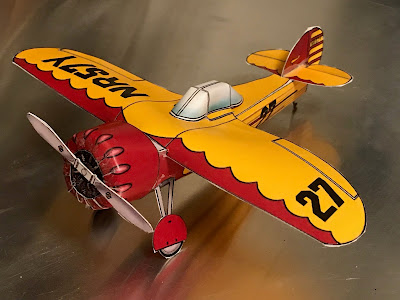Pinterest is a great source for paper models. I have found several available for download. Another good source is fiddlersgreen.net, they have a large variety of plans available. Not just planes, but much more.
Over the last couple of months, I have built the models shown below.
 This first plane is a 1933 Cessna Racer (CR-3). The CR3 was built for John Livingston who won first place in several races. He set the world speed record for 500 cu inch engines at 204.35 mph at the 1933 Chicago Air Races.
This first plane is a 1933 Cessna Racer (CR-3). The CR3 was built for John Livingston who won first place in several races. He set the world speed record for 500 cu inch engines at 204.35 mph at the 1933 Chicago Air Races.  The Wedell-Williams Model 44 is a racing aircraft, four examples of which were built in the United States in the early 1930s by the Wedell-Williams Air Service Corporation. It began as a rebuilding of the partnership's successful We-Will 1929 racer, but soon turned into a completely new racing monoplane aircraft, powered by a large radial engine. Model 44s became the dominant racers of the 1930s, setting innumerable records including setting a new world speed record in 1933.
The Wedell-Williams Model 44 is a racing aircraft, four examples of which were built in the United States in the early 1930s by the Wedell-Williams Air Service Corporation. It began as a rebuilding of the partnership's successful We-Will 1929 racer, but soon turned into a completely new racing monoplane aircraft, powered by a large radial engine. Model 44s became the dominant racers of the 1930s, setting innumerable records including setting a new world speed record in 1933. Piper PA-22 TRI Pacer - The Piper PA-22 Tri-Pacer was introduced in 1952 and remained in production through 1960. Early Tri-Pacers were powered by the 124-hp O-290-D Lycoming engine. By 1959, the Caribbean model had the 150-hp O-32O-B rated at 160 hp. Prices ranged from $8,395 to $10,770, depending upon engine installation and the usual extra-cost options. A total of 7,668 Tri-Pacers were built.
Piper PA-22 TRI Pacer - The Piper PA-22 Tri-Pacer was introduced in 1952 and remained in production through 1960. Early Tri-Pacers were powered by the 124-hp O-290-D Lycoming engine. By 1959, the Caribbean model had the 150-hp O-32O-B rated at 160 hp. Prices ranged from $8,395 to $10,770, depending upon engine installation and the usual extra-cost options. A total of 7,668 Tri-Pacers were built. Beechcraft Staggerwing - Once in a while something is created that establishes a concept and all other things that follow merely attempt to capture the quality and capability of the original. Walter Beech began the Beech Aircraft Company in Wichita Kansas in the pit of the depression, 1932. His first aircraft was a non-retractable version. From then on general aviation would measure all aircraft against this machine as the standard. Besides speed, the Staggerwing offers stylish lines, a roomy cockpit, and great flying characteristics, which rank it as an "ultra classic".
Beechcraft Staggerwing - Once in a while something is created that establishes a concept and all other things that follow merely attempt to capture the quality and capability of the original. Walter Beech began the Beech Aircraft Company in Wichita Kansas in the pit of the depression, 1932. His first aircraft was a non-retractable version. From then on general aviation would measure all aircraft against this machine as the standard. Besides speed, the Staggerwing offers stylish lines, a roomy cockpit, and great flying characteristics, which rank it as an "ultra classic". The Cessna 152 is an American two-seat, fixed tricycle gear, general aviation airplane, used primarily for flight training and personal use. It was based on the earlier Cessna 150, including a number of minor design changes and a slightly more powerful engine running on 100LL aviation gasoline.
The Cessna 152 is an American two-seat, fixed tricycle gear, general aviation airplane, used primarily for flight training and personal use. It was based on the earlier Cessna 150, including a number of minor design changes and a slightly more powerful engine running on 100LL aviation gasoline.
The Cessna 152 has been out of production for more than thirty years, but there are still a large number of aircraft in flying condition. Due to the aircraft's durability, many examples have flown more than 15,000 hours and over 60,000 landings and are still in regular use for flight training.
No comments:
Post a Comment